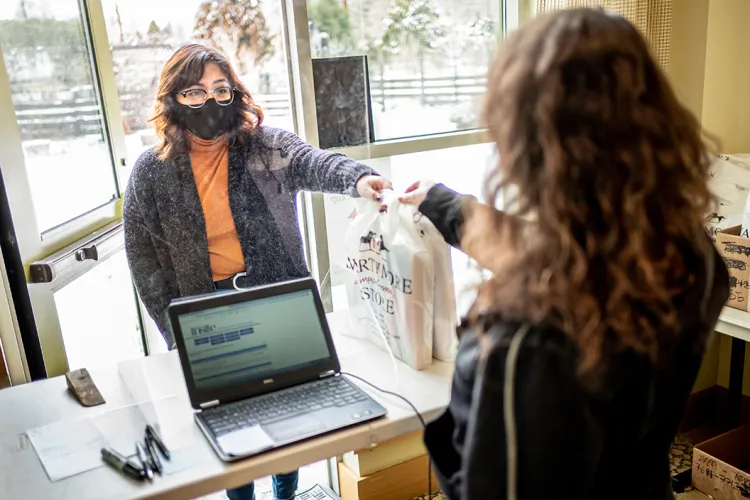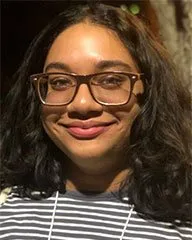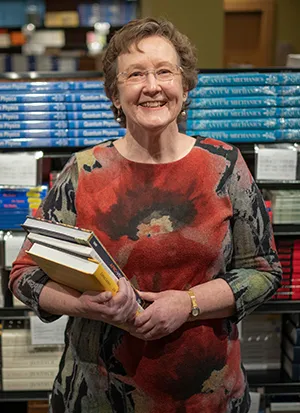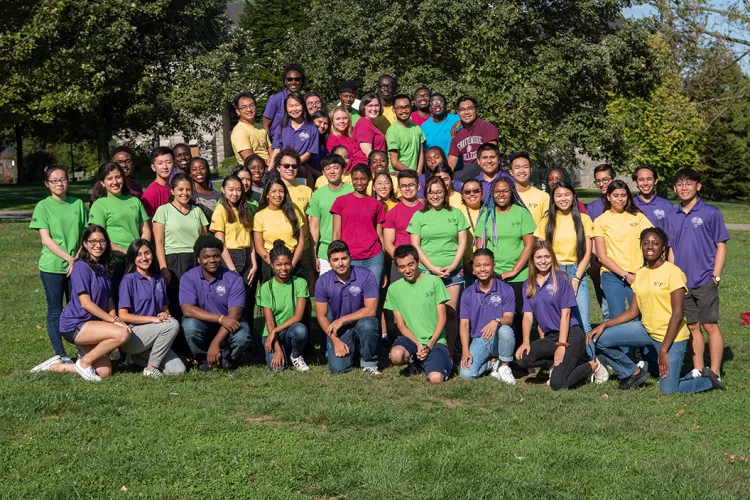Textbook Affordability Program Opens Options for Students While Closing Course-Materials Gap

“It’s a privilege to not just be renting textbooks, to actually own them and have them as reference,” says Edna Olvera '21, pictured above. “It’s great not to have to worry about it at all, just to know that the cost was taken care of.”
When Aleina Dume ’23 was preparing for her first year at Swarthmore, she knew she needed to have money saved to buy books and other course materials — an expense that typically costs hundreds of dollars a semester.
“I had taken a summer job before Swarthmore, preparing for all those costs,” says Dume, a first-generation college student and Lang Opportunity Scholar from Queens, N.Y. “But at the same time, I didn’t want to spend all my money on books because there were so many other things to buy for college.”
Instead, she made do by borrowing her required books from McCabe Library, extending her checkouts as long as possible as she completed her readings. The tradeoff for the money saved, she says, were hours spent stressing about how that time would’ve been better spent focusing on her classes.
Situations like Dume’s are not unique to Swarthmore, especially in recent years as textbook costs have soared. But a new College initiative that assists students in affording their books aims to improve this course-materials gap.
Launched this fall, the Textbook Affordability Program (TAP) provides every Swarthmore student with a $700 annual credit that can be used on required course materials at the Swarthmore Campus & Community Store. In addition to textbooks — whether hard copy or digital, new or used, purchased or rented — the money can be applied toward workbooks, access codes, molecular model kits for chemistry, and other supplies deemed required for a course as noted by the syllabus.
“It’s one less thing to worry about,” says Dume, who recently penned an op-ed in Teen Vogue on the hidden costs of course materials. “There are so many things happening right now beyond normal college life responsibilities. It’s nice to not have that pressure.”
Vice President of Finance and Administration Greg Brown, who co-led the cross-disciplinary committee that developed TAP, says faculty helped to inform the decision to start the initiative. Beyond borrowing books from the library or classmates, or forgoing them altogether, Brown says, some students were even avoiding certain courses based on the expected cost of materials.
“We wanted to make sure that all of our students were on an equal footing,” Brown says. “I saw this as an equity issue more than anything else.”
Piloting the program
According to the U.S. Bureau of Labor Statistics, textbook prices rose 88% from 2006 to 2016, largely the result of ecommerce cutting into publishers’ profits, says Paula Dale, director of the Swarthmore Campus & Community Store and a member of Swarthmore’s Textbook Affordability Committee. With the price of a single textbook routinely topping $100, the cost of required course materials often puts a financial strain on students, particularly those who come from low-income backgrounds.
Historically, textbook costs have been listed in financial aid packages as a “non-billed,” out-of-pocket expense, with Swarthmore students and families expected to contribute up to $1,400 annually for required course materials. But work-study programs that could help cover these costs don’t typically start until after courses begin, Brown notes, leaving many students without the money they need up front to purchase their books.
To examine these issues and explore options for resolving them, the College convened the textbook committee in 2016. The panel — led by Brown as well as Provost and Dean of the Faculty Sarah Willie-LeBreton and Vice President for Student Affairs Jim Terhune — spent months reviewing textbook-assistance programs at peer institutions to develop a pilot program for Swarthmore.
For the pilot, dubbed Textbook 400, the committee partnered with the Swarthmore Summer Scholars Program (S3P), a group of students who are either first-generation or from low-income backgrounds, or from underresourced high schools or traditionally underrepresented groups on campus. For four semesters, 62 students from S3P were given a $400 credit at the Swarthmore Campus & Community Store to spend on required course materials. In exchange, the students were regularly surveyed while their expenses were closely tracked.

Aleina Dume ’23
The feedback was overwhelmingly positive, says S3P Director and textbook committee member Amy Cheng Vollmer, the Isaac H. Clothier Jr. Professor of Biology. In survey results after two semesters, with an 80% response rate, 100% of responding S3P students said they were satisfied with the program — 90% very much so — with only five or six having required materials that exceeded their $400 allotment.
For Adam Agustin ’20, Textbook 400 helped to remove the worry of how he’d afford his next textbook while allowing him to rebudget his savings toward paying for application costs and other scholarly opportunities.
“I also didn’t have to rely anymore on scrolling through sketchy electronic copies or going to the library every time I needed to make copies of a textbook,” says Agustin, a biology major now working with Teach for America in Hawaii. “It ended up saving me so much time and energy to actually focus on the work I needed to have done.”
It’s responses like Agustin’s that show how much TAP was truly needed on campus, Vollmer says: “If some of that extra expenditure of energy can now be focused on looking forward to coming to class rather than dreading it because you haven’t had a chance to read, I think that's amazing.”
The surveys also revealed a deep level of gratitude among the students, and a strong desire to pay it forward, Vollmer says.
“The thing we heard from these kids over and over again is, ‘I wish I could give what’s left over in my account to my roommate,’” she says. “They were trying to share their benefits in a way that Swarthmore students do.”
Full rollout
The fully launched Textbook Affordability Program is now provided to all Swarthmore students, regardless of whether they receive financial aid. Although the total annual credit was reduced slightly to help it stretch across the student body, any leftover balance from the $700 allotment carries over from fall to spring, allowing for greater flexibility in covering semester costs.
The College had planned to roll the additional expenses for TAP into student tuition. However, even with tuition frozen due to the coronavirus, TAP was fully approved for the 2020–21 school year. “We basically reduced other costs in order to make room for it,” says Brown. “We thought it was the right thing to do.”
With the pandemic, the committee faced the challenge of spreading the word about how the program works to remote students and faculty members, says Dale, the director of Swarthmore’s bookstore. For students to see the most benefit from the program, faculty must submit their textbook requests on time so that the bookstore has a better chance of securing used books that are less expensive for the students.

Paula Dale
Although similar programs at peer schools have restricted the format of books covered by their funding, leaning heavily toward digital purchases or rentals, Dale says, Swarthmore’s committee stayed committed to covering all versions of the texts — expanding the options available for both students and professors.
“They were our partners in this,” Dale says about the faculty, “and we did not want to go to them and say, ‘I know you’ve used that book for years, but forget it because it’s not covered.’
“There’s a growing understanding that academically intensive colleges like ours tend to use more primary materials, and primary materials are the ones that are the least likely to be digital,” Dale adds. “So, yes, the Bio 001 textbook that 80% of the college students in America use is available digitally. But Edna Lewis’s cookbook In Pursuit of Flavor, which is one of the required textbooks for a course on Black women’s history through food and literature, is not available in digital format. And that’s the wonderful kind of book that our faculty love to teach.”
It’s also the kind of book that Swarthmore students love to keep, says Vollmer. Before the assistance programs, she recalls students from S3P admiring her collection of biology textbooks, lamenting whether they’d ever be able to afford a personal library of their own.
“It’s part of your identity as a scholar,” she says. “They don’t want the digital copy — they want the book. It’s like your badges on your Girl Scout sash: ‘I did this.’ I took this course. It almost took me, but I’m still standing.”
Expanding opportunities

To pilot the program, 62 students from S3P (above) were given a $400 credit at the Swarthmore Campus & Community Store to spend on required course materials.
As an S3P student in the pilot program, Edna Olvera ’21 began handing down her textbooks to younger students in her major. She saw it as her way of helping those who weren’t receiving the benefit. Some majors, she notes, are notorious for the cost of their course materials — her large physics textbooks, for instance, cost far more than the chapter books required for her religion and educational studies courses.
Now that everyone has access to TAP, Olvera says, each student has the option of building a collection of materials they can use throughout their academic careers, both at Swarthmore and beyond. “It’s a privilege to not just be renting them, to actually own them and have them as reference books,” says Olvera, an astrophysics and educational studies major from Houston, Texas. “It’s great not to have to worry about it at all, just to know that the cost was taken care of.”
Alumni and friends of the College have recognized the benefits of TAP, as well. This past holiday season, in conjunction with Giving Tuesday, the College launched the “Buy the Book” initiative. Through the monthlong gift campaign, 1,000-plus donors gave more than $133,000 toward the cost of course materials for students on financial aid. The campaign inspired one anonymous matchbox couple from the Class of 1993 to contribute $60,000 as part of two matched gifts tied to alumni challenges.
Above all, Brown says, TAP is about diversity, equity, and inclusion — and about helping all Swarthmore students thrive.
“It’s not enough to get into Swarthmore; it’s more important that we make sure that students succeed,” says Brown. “The barriers created by not having textbooks just goes in the face of who we say we are as an institution, so it was absolutely essential for us to get up in front of this.
“It was a problem, and it was within our bandwidth to fix it.”



